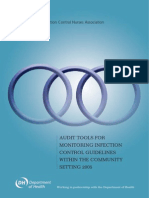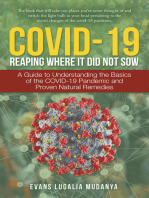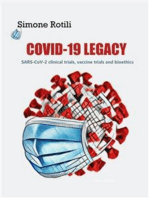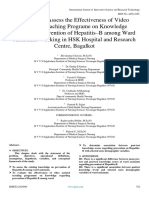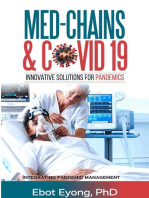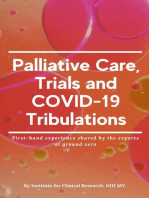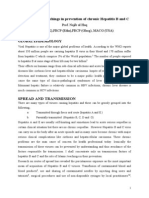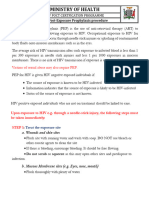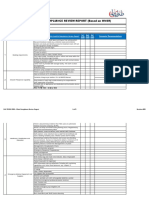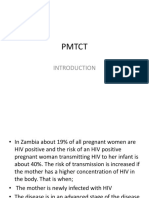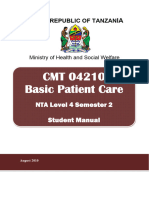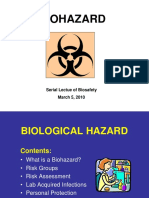Knowledge, Attitude and Practice of Nurses and Midwives Towards Hepatitis B Infection and Control Measures in Alban Gaded Hospital, Khartoum, Sudan
Knowledge, Attitude and Practice of Nurses and Midwives Towards Hepatitis B Infection and Control Measures in Alban Gaded Hospital, Khartoum, Sudan
Volume 9, Issue 10, October – 2024 International Journal of Innovative Science and Research Technology
ISSN No:-2456-2165 https://doi.org/10.38124/ijisrt/IJISRT24OCT293
بسم هللا الرحمن الرحيم
Ibn Sena University
Faculty of Medicine
Department of community medicine
Knowledge, Attitude and Practice of Nurses and
Midwives towards Hepatitis B Infection and
Control Measures in Alban Gaded Hospital,
Khartoum, Sudan
Thesis submitted for partial fulfillment of requirements for MBBS Degree
Submitted By:
Mohammed Abdelmoniem Kamal Eldin Elnoor; Ahmed Atif Mohamed Ali
Supervisor:
Dr. Hiba Ahmed Khalil
IJISRT24OCT293 www.ijisrt.com 901
Volume 9, Issue 10, October – 2024 International Journal of Innovative Science and Research Technology
ISSN No:-2456-2165 https://doi.org/10.38124/ijisrt/IJISRT24OCT293
TABLE OF CONTENTS
ACKNOWLEDGMENT
ABSTRACT
CHAPTER ONE: INTRODUCTION
A. Background
B. Problem Statement
C. Justification
D. Objectives
CHAPTER TWO: LITERATURE REVIEW
CHAPTER THREE: METHODOLOGY
CHAPTER FOUR
CHAPTER FIVE
CHAPTER SIX
CHAPTER SEVEN
CHAPTER EIGHT
REFERENCES
ANNEXES
IJISRT24OCT293 www.ijisrt.com 902
Volume 9, Issue 10, October – 2024 International Journal of Innovative Science and Research Technology
ISSN No:-2456-2165 https://doi.org/10.38124/ijisrt/IJISRT24OCT293
LIST OF ABBREVIATIONS
HBsAg Hepatitis B surface antigen
HBV Hepatitis B virus
HCWs Healthcare workers
IG Immunoglobulin
KAP Knowledge, attitude and practice
MTCT Mother to child transmission
NSI Needlestick injury
PEP Post exposure prophylaxis
IJISRT24OCT293 www.ijisrt.com 903
Volume 9, Issue 10, October – 2024 International Journal of Innovative Science and Research Technology
ISSN No:-2456-2165 https://doi.org/10.38124/ijisrt/IJISRT24OCT293
ACKNOWLEDGMENT
We would like to thank our esteemed supervisor – Dr. Hiba Ahmed Khalil for her supervision, support and tutelage during the
course of our research. Our gratitude extends to The University of Ibn Sina and the Faculty of Medicine for the support that eased
our data collection work at Alban Gaded Hospital. Respectively, special thanks to Alban Gaded hospital for cooperating in making
sure we reached full coverage. Additionally, we would like to express gratitude to the participants’ treasured support which was
really influential in conducting the research easily and rightfully. Our appreciation also goes out to our families and friends for their
encouragement and support all through our studies.
IJISRT24OCT293 www.ijisrt.com 904
Volume 9, Issue 10, October – 2024 International Journal of Innovative Science and Research Technology
ISSN No:-2456-2165 https://doi.org/10.38124/ijisrt/IJISRT24OCT293
ABSTRACT
Purpose:
Infection with the hepatitis B virus (HBV) causes severe morbidity and death, burdening world health. Nurses and
midwives, among other healthcare professionals, are more likely to contract the illness. Few studies have looked at the
knowledge, attitude, and practices (KAP) of healthcare professionals in Sudan with regard to HBV infection, despite the
fact that diverse components of KAP have an impact on health-related behaviors. This study's objective was to assess the
knowledge, attitude, and practice (KAP) level of nurses and midwives concerning HBV viral infection in, Khartoum, Sudan.
Methods:
In the Sudanese state of Khartoum, a public hospital (Alban Gaded Hospital) underwent a cross-sectional descriptive
hospital-based study.
To assess KAP's understanding of nurses and midwives about HBV infection.
Self-administered questionnaires were used and approved by the supervisor for distribution to the population chosen
for the study. The data was handed over to the Medical Director whom personally ensured the questionnaires were signed
and filled by the Healthcare workers (HCWs) of the chosen criteria at the field. A member of group (23:B) took care of the
supervision aside with the medical director, and made sure the data was collected as needed.
The data at hand were subjected to statistical analysis using SPSS version 24.0 (Statistical Package for Social Sciences).
Results:
95 samples out of 99 were collected. According to participants’ knowledge: 67.95% have good knowledge about HBV,
while 32.05% lack basic knowledge about it. The participants’ attitude towards HBV is above average showing 60.3% safe
attitude. Lastly, the study shows excellent practice of the participants’ behavior towards HBV safety measures with a score
of 92.3% safe practice.
From the hospital, a total of 95 out of 99 nurses and midwives took part in the study. Two thirds of the respondents
practiced safety, and the majority of respondents had a positive attitude about HBV preventative measures. More than half
of the respondents (58.2%) had an average level of understanding. A minor but serious score of (12.6%) was noticed of the
individuals, dealing with patients without wearing gloves. More over half of the nurses and midwives were not vaccinated
against HBV; more than 50% of participants had incorrect ideas regarding the symptoms and route of HBV infection and
all 95 participants voted (NO) for ever being infected by HBV.
Conclusion:
In Alban Gaded hospital, the majority of the nurses and midwives were aware of HBV infection. But a sizeable majority
of the participants lacked the necessary understanding of early immunization after birth. The study found a probability of
high risk infection due to exposure under the poor level of HBV vaccine coverage rate. Moreover a clear point of limitation
was noticed in Table 4 third question, where it asks whether you are or ever was infected by HBV. All the participants
denied, showing a sense of partiality. Further occupational exposure prevention measures, training programs on HBV
infection, including post-exposure prophylaxis, and increasing the vaccination rate of all HCWS are also strongly
encouraged.
Keywords:- Knowledge, Attitude and Practice; Nurses and Midwives; Hepatitis B; Control Measures; Khartoum, Sudan.
IJISRT24OCT293 www.ijisrt.com 905
Volume 9, Issue 10, October – 2024 International Journal of Innovative Science and Research Technology
ISSN No:-2456-2165 https://doi.org/10.38124/ijisrt/IJISRT24OCT293
CHAPTER ONE
INTRODUCTION
A. Background:
Acute and chronic consequences of the hepatitis B virus (HBV) infection, such as chronic hepatitis, cirrhosis, and
hepatocellular cancer, result in considerable morbidity and death worldwide [1–5]. Globally, there were 240 million hepatitis B
surface antigen (HBsAg) positive individuals in 2005, up from 223 million in 1990 [6]. A significant public health issue, hepatitis
B affects about 10% of the world's population. The 2009 WHO study estimates that there are around 2 billion HBV-positive persons
globally, more than 350 million of whom have a chronic, lifelong infection, and more than one million people die each year from
cirrhosis and liver cancer [2, 4]. Additionally, 170 million people are thought to have chronic HCV infection [5]. In the developing
world, notably in Asia and sub-Saharan Africa, the prevalence of HBV infection is greatest. According to WHO estimates, more
than 10% of people in Africa have HBV infection. But according to a research carried out in Addis Ababa, Ethiopia, the mean
prevalence of HBsAg was 6.1% [4].
Estimates of the frequency of HBV infection in various Sudanese groups have been published by multiple researchers [3, 7, 8,
and 9]. In Sudan, a recent systematic review and meta-analysis of 14 studies including 5848 people found that the seroprevalence
of HBV varied from 5.1 to 26.8%, with a pooled prevalence of 12.1%. Khartoum State has the highest incidence of HBV infection
in Sudan, with a proportion of 12.7%, according to study results [1]. This rate is greater than that of Nigeria (5%), Ethiopia (6.1%),
and other African nations like Burundi (15.6%), Central African Republic (14%) [2].
According to the Centers for Disease Control (CDC), 3.9 million people (1.8%) have HCV infections, and 2.7 million of these
infections will progress to chronic disease [1]. Between 5 and 10% of voluntary blood donors have anti-HB viral antibodies.
However, those with poorer socioeconomic levels, older age groups, and those exposed to blood products have a greater prevalence
[2]. According to estimates, hospital staff members had HBV and HCV infections at rates of 14.4% and 1.4%, respectively [1].
People working in healthcare environments, especially support employees, are at a significant risk of contracting severe, even fatal
illnesses like HIV and HBV. The most typical or frequent danger that healthcare professionals face when providing patient care is
direct contact with blood and other bodily fluids [3]. According to studies conducted in the US, there is a 27–37% chance of
contracting HBV after receiving a needle stick from a patient who has the virus. Additionally, there was a 3 to 10% chance of
contracting HCV through a needle stick from an infected person. Hepatitis B transmits with a high rate of efficiency. For instance,
a vulnerable host can get HBV from an unintentional splash of as little as 108 ml of contaminated blood in the eye [6]. Since it was
developed 20 years ago, the HBV vaccine is safe and efficient in avoiding infection as well as the major side effects of hepatitis,
such as liver cancer and cirrhosis [2]. It may be administered either before or after exposure. There is currently no HCV vaccine [5].
All people at risk of coming into touch with blood, blood products, or body fluids should have the hepatitis B vaccination
before and/or after exposure. Hepatitis B vaccination should ideally be finished before beginning training as a health professional
since it is assumed that the risk of infection is higher at this period. As it provides long-term, probably lifetime protection from
hepatitis B infection, immunizing healthcare workers (HCWs) against the virus inhibits nosocomial transmission of the virus from
HCWs to patients and from patients to HCWs [2, 7].
The clinician's attitudes and knowledge are crucial in preventing the spread of illness. Therefore, the goals of this study were
to evaluate nurses' and midwives' knowledge, attitudes, and practice about hepatitis B. Correlating awareness of hepatitis B and C
infection with clinical practice and attitudes toward these diseases is another essential goal of this study, and it will help determine
how information and education may affect attitudes and practices.
Summary of Similar Study
A hospital-based study was conducted in Saudi and Saad Abu-Ella hospitals in Khartoum, Sudan between August 18 and
September 2, 2016.
The total number of nurses and midwives working in the two participating hospitals was 150. The inclusion criteria for this
study were the nurses and midwives working in these two hospitals.
Data Collection and Analysis
The study implemented a structured 31-item questionnaire to examine the level of KAP of nurses and midwives towards
hepatitis B virus infection. Data were collected from the HCWs, 15 questions for knowledge, 4 questions for attitude, and 6 questions
for practice. The main purpose of knowledge questions was to measure basic knowledge about etiology, natural history, modes of
transmission, complications, and PEP to HBV. The questions regarding the practice section aimed to measure whether the
participants received the HBV vaccine, sterilized instruments, and wore gloves.
IJISRT24OCT293 www.ijisrt.com 906
Volume 9, Issue 10, October – 2024 International Journal of Innovative Science and Research Technology
ISSN No:-2456-2165 https://doi.org/10.38124/ijisrt/IJISRT24OCT293
Results
A total of 110 nurses and midwives from the both hospitals participated in this study. More than half of the respondents (58.2%)
had an average level of knowledge, two-third of the respondents had a safe practice, and the majority of the respondents had a
favorable attitude towards HBV preventive measures. Approximately half of the participants (51.8%) had a history of needle stick
injuries
Conclusion
Most of the nurses and midwives in Saudi and Saad Abu-Ella hospitals were aware of HBV infection. However, a significant
proportion of the participants lacked the requisite knowledge about post exposure management. The study revealed a low level of
HBV vaccination coverage rate and a high rate of needle stick injuries.
B. Problem Statement:
Hepatitis B virus causes liver disease and up to 2 billion people have been in contact with the virus worldwide. It can cause
both acute and chronic disease. The routes for transmission are through blood, mother to infant at time of delivery and sexually.
Chronic hepatitis B infection is a risk factor for development of liver cirrhosis and hepatocellular carcinoma. Prevention of hepatitis
B virus infection is highly desirable. Since the early1980s hepatitis B vaccine has been available. It can effectively prevent the
disease and has been found to be safe. The World Health Organization, WHO, has recommended all countries to implement the
vaccine in their children’s vaccination programs and many countries have followed this recommendation.
This research is to help assess the percentage of health workers in Al Ban Gadeed who are knowledgeable towards infection
control measures of hepatitis B.
C. Justification:
Hepatitis is more likely to affect nurses and midwives because it is one of the most prevalent causes of morbidity in the world
and spreads easily through contact. It is less likely to contract the disease if people are aware of it. The implementation of blood
safety measures, infection control measures in healthcare and community settings, safe injection and sex practices, and harm
reduction techniques for injecting drugs are just a few of the strategies listed in WHO records as part of a comprehensive approach
to the prevention of viral hepatitis that can help reduce transmission, inhibiting the spread of HAV, HBV, and HCV. All healthcare
professionals need to get health education on hepatitis B/C infection through the administration of awareness programs in order to
raise awareness of this disease.
D. Objectives:
General Objective:
To assess knowledge, attitude and practice of nurses and midwives towards infection control measures of hepatitis B infection
in Alban Gaded hospital, Khartoum north, Sudan.
Specific Objectives:
To know the knowledge of nurses and midwives about the infection control measures of hepatitis B in Alban Gaded hospital.
To identify the attitude of nurses and midwives towards the infection control measures of hepatitis B in Alban Gaded hospital.
To assess the practice of nurses and midwives towards hepatitis B infections in Alban Gaded hospital.
IJISRT24OCT293 www.ijisrt.com 907
Volume 9, Issue 10, October – 2024 International Journal of Innovative Science and Research Technology
ISSN No:-2456-2165 https://doi.org/10.38124/ijisrt/IJISRT24OCT293
CHAPTER TWO
LITERATURE REVIEW
A. Study no.1:
In 2017, Adel Saeed Al Qahtani and Metrek Ali Almetrek conducted a retrospective study in Saudi Arabia with the goal of
identifying the knowledge, attitudes, and practices of nurses working in dialysis units about common guidelines for infection
management. Between December 2016 and January 2017, a cross-sectional survey with all nurses in three dialysis facilities
connected to the Ministry of Health in Abha city was carried out. A self-administered questionnaire was used to get data on nurses'
KAP, and an observation checklist was used to gather information on ambient factors. A total of 109 nurses participated, with a
response rate of 94.78%. The majority of them (62.39%) were Saudi citizens and had a diploma (78.90%). The knowledge score
was 60.18+17.51, attitudes were 85.59+8.09, and practice was 92.11+7.98. Despite the lack of education, the number of nurses
practicing was high. The use of eye protection when blood splash is expected (31.19%), simultaneous care for positive and negative
patients (24.77%), moving needles from hand to hand (29.36%), and recapping needles after use (25.69%) are only a few of the
gaps in practice that were found. According to multivariate linear regression analysis, practice scores were independently predicted
by attitudes about infection control, attempts to acquire infection control guidelines, on-the-job training, and not being Saudi.
Although nurses lack sufficient information, their attitudes have a huge impact on their performance, certain infection control
procedures are more frequently followed by nurses than others. Training in infection control should focus on developing a positive
attitude while addressing performance gaps [11].
B. Study no.2:
In 2018, Masomeh Rostamzadeh, Abdorrahim Afkhamzadeh, Sirus Afrooz, Kaveh Mohamadi, and Mohammad Aziz Rasouliin
conducted a retrospective study in Sanandaj, Iran, with the goal of assessing the Knowledge, Attitude, and Practices (KAP) of
healthcare professionals, including doctors, dentists, nurses, and lab workers, with regard to infection control and fundamental
principles. In Sanandaj, Iran, 106 dentists were recruited for this cross-sectional study. Regarding hepatitis B virus (HBV), hepatitis
C virus (HCV), and HIV/AIDS, the dentists' KAP was assessed. To evaluate differences between the groups, one-way ANOVA,
the student's t-test, and the chi-square test were applied. Stata 12 was used to analyze the data. The findings indicated that women
(53.8%) made up the bulk of the study population's participants. Age and work experience had mean standard deviations (SD) of
39.6 9.80 and 10.6 8.7 years, respectively. Participants' knowledge, attitudes, and behaviors had corresponding mean SD values of
37.3 3.01, 22.9 4.80, and 24.07 5.06, respectively. The findings also showed that job experience (more than ten years; significant
influence) had a significant impact on dentists' greater degree of knowledge of HBV, HCV, and HIV/AIDS. P 0.001) and the year
of graduation (after 2006: P 0.001). Age group (30 years: P = 0.021), work experience (10 years: P 0.001), and workplace (dental
office: P = 0.016) all had a significant impact on respondents' positive attitudes toward HBV, HCV, and HIV/AIDS. The study's
findings showed that dentists have a satisfactory level of knowledge and attitudes about HBV, HCV, and HIV/AIDS infections, but
some gaps were also found, suggesting that dentists' higher levels of knowledge are crucial in influencing their practices and attitudes
toward patients who have these infections [12].
C. Study no.3:
Sanaa Mohammed-elbager Mahmoud Mursy and Sagad Omer Obeid Mohamed did a retrospective study in Khartoum, Sudan,
in 2019 with the goal of determining the KAP level of nurses and midwives toward HBV virus infection there. In the Sudanese state
of Khartoum, two public maternity hospitals (Saudi and Saad Abul-Eleella hospitals) underwent a cross-sectional descriptive
hospital-based study. To assess KAP's attitude about HBV infection, a pre-tested structured questionnaire was developed and put
into use. The data at hand were subjected to statistical analysis using SPSS version 21 (Statistical Package for Social Sciences). To
assess the association between categorical variables, the chi-square test was performed. From the two hospitals, a total of 110 nurses
and midwives took part in the study. Two thirds of the respondents practiced safety, and the majority of respondents had a positive
attitude about HBV preventative measures. More than half of the respondents (58.2%) had an average level of understanding. A
history of needle stick injuries was present in 51.8% of the individuals. More than half of the nurses and midwives did not follow
the HBV vaccine schedule, and 50% of participants had incorrect ideas regarding post-exposure prophylaxis for HBV infection. In
Saudi Arabian and Saad Abul-Eleella hospitals, the majority of nurses and midwives were aware of HBV infection. But a sizable
majority of the participants lacked the necessary understanding of after exposure treatment. The study found a high risk of needle
stick injuries and a poor level of HBV vaccination coverage rate. It is strongly advised to implement further workplace exposure
prevention measures, implement training programs on HBV infection, including post-exposure prophylaxis, and raise the
vaccination rate of all HCWS [13].
D. Study no.4:
In 2020, Hind Abdallah Modawi, Manal Bilal Mohamed, Iman Khalifa Abdel Gadir, Norah Hassan Ahmed, and Khadijah
Mohammed Ismail Zaeri conducted a retrospective study in Saudi Arabia with the goal of assessing nursing students' knowledge,
attitudes, and practices (KAP) regarding hepatitis B virus infection at the Sabya Campus of Jazan University. A validated
questionnaire was used in a cross-sectional study to gauge nursing students' knowledge of hepatitis B and C infection. In 2020, the
investigation was carried out between May and June. Using IBM SPSS Statistics version 20, data from 60 students in levels 4
through 8 were evaluated. Frequency and proportion analyses using descriptive statistics were carried out. Age, educational
IJISRT24OCT293 www.ijisrt.com 908
Volume 9, Issue 10, October – 2024 International Journal of Innovative Science and Research Technology
ISSN No:-2456-2165 https://doi.org/10.38124/ijisrt/IJISRT24OCT293
attainment, and married status were employed as independent variables, and the connection between these factors and the desired
outcome was examined using the Chi-squared test (knowledge, attitude, and practice, related to hepatitis B and C). Statistical
significance was defined as a p-value 0.05. In the study, 60 students took part, and 51.7% of them demonstrated strong knowledge.
Only 16.7% of them had positive attitudes, while 48.3% of them had negative attitudes toward those who carried the hepatitis B
virus. 76.7% of businesses used ethical business practices. Marriage status and attitudes concerning HBV infection were shown to
be significantly different (p=0.024). The study places a strong emphasis on the value of ongoing HBV education for enhancing
understanding and attitudes around HBV infection [14].
In order to evaluate the knowledge, attitudes, and practices (KAP) of HBI prevention among nursing students in the Upper
West Region of Ghana in 2021, Augustine Ngmenemandel Balegha, Adadow Yidana, and Gilbert Abotisem Abiiro conducted a
retrospective study. In November 2020, they gave a stratified random sample of 402 nursing students from two nursing training
colleges in the Upper West Region an online cross-sectional survey. They generated composite KAP of HBI prevention scores using
STATA version 13, with a maximum score of 18 for knowledge and 8 each for attitude and practice. To evaluate the variables
connected to the practice of HBI prevention, a generalized ordered logistic regression model was used. The students' knowledge
and attitude had moderate median scores (12.00; IQR = 10-13) and 6.00; IQR = 5.00-7.00, respectively, however their performance
in the practice of HBI prevention had a poor median score (5.00; IQR = 4.00-6.00). Being a male, second-year student, having
parents with tertiary education, having high knowledge (aOR = 2.05; p = 0.06), and having a positive attitude were all substantially
linked with higher likelihoods (aOR >1; p 0.05) of exhibiting good practice of HBI prevention. Students who had never been married
were substantially less likely to conduct adequate HBI prevention (aOR = 0.34; p = 0.010). The kids' KAP scores for preventing
HBI were below average. They advocate for institution-based HBI prevention policies and regular education, free or low-cost HBI
preventive services, and the implementation of appropriate professional ethics on HBI prevention in nurse training institutions.
These initiatives ought to primarily target female, single, and first-year nursing students [15].
IJISRT24OCT293 www.ijisrt.com 909
Volume 9, Issue 10, October – 2024 International Journal of Innovative Science and Research Technology
ISSN No:-2456-2165 https://doi.org/10.38124/ijisrt/IJISRT24OCT293
CHAPTER THREE
METHODOLOGY
A. Study Design
A descriptive hospital-based cross-sectional study.
B. Study Area
Alban Gaded Hospital in Khartoum state, Sudan. This area was chosen because it’s a teaching hospital for students and it’s
also a public health, tertiary healthcare facility providing specialized clinical inpatient and outpatient services for a great number of
the Khartoum state population. This hospital is a popular health facility specialized in obstetrics and gynecology services aside from
other departments. Khartoum state is the most populous state in Sudan with a population of more than 5 million in the 2008 census.
The state has experienced rapid urbanization during the last decades, and the large part of the state’s population has reported that
their region of origin is outside Khartoum. The state is divided into seven localities. The distribution of public and private hospitals
in these localities is made according to the population density.
C. Study Population:
The total number of nurses and midwives working at the participating hospital are 99 (80 nurses and 9 midwives in the
emergency room and the patients’ admission sector of obstetrics, and 10 nurses in the department of urology).
Inclusion Criteria:
The inclusion criteria for this study were all the nurses and midwives working at the two sectors mentioned above.
Exclusion Criteria:
The exclusion criteria for this study were the other departments and those refusing to participate in the study.
D. Sampling:
Sample Frame:
Sample size: sample size is 76. Sample size was calculated using the formula:
n = (Z2 x P x (1 - P))/e2
Where:
Z = value from standard normal distribution corresponding to desired confidence level
(Z=1.96 for 95% CI)
P is expected true proportion
e is the desired precision (half desired CI width).
Sampling Technique:
Purposeful random sampling technique was the technique used for selection of the study participants because it is the method
of picking instances in a methodical manner without using ahead knowledge of how the results will turn out yet, identifying a
population of interest. Increasing credibility, not encouraging representativeness, was the goal.
E. Instruments of Investigation:
The data was collected using a self-administered questionnaire containing 27 questions, all written for objective achievement.
The questionnaire was divided into four parts:
Sociodemographic Data: Which contains the variable data, and it includes 4 questions
Knowledge level on Hepatitis B: This contains closed question (YES OR NO) counting to be 12 questions
Attitude towards hepatitis prevention: This contains closed (YES or NO) counting to be 6 questions
Practice in preventing Hepatitis B: This contains closed (YES or NO) counting to be 5 questions.
The data was collected from Alban Gaded hospital.
Demographic Data:
The collection of data was obtained using questionnaires that included 27 questions all questions were written for objectives’
achievement.
Dependent Variables:
The collection of data was based on age, gender, level of education, marital status, Knowledge, attitude and practice.
IJISRT24OCT293 www.ijisrt.com 910
Volume 9, Issue 10, October – 2024 International Journal of Innovative Science and Research Technology
ISSN No:-2456-2165 https://doi.org/10.38124/ijisrt/IJISRT24OCT293
F. Data Management and Analysis:
The study implemented a 27-item structured questionnaire consisting of one section for the personal information and three
sections to examine the KAP level of nurses and midwives towards HBV infection. The data were collected from HCWs who met
eligible criteria. The structured questionnaire consisted of four questions for demographic information, 12 questions for knowledge,
six questions for attitude, and five questions for practice.
The main purpose of the knowledge questions was to measure the basic knowledge about etiology, natural history, modes of
transmission, complications, and PEP to HBV. The response set of these questions was set as “yes” and “no” choices. Respondents
with favorable attitudes are those who answered questions which indicated that they don’t share needles, and also believed that early
immunization at birth and vaccination are important to prevent HBV transmission recommending PEP for those who had been
exposed to HBV. The questions regarding the practice section aimed to measure whether the participants would ensure their patients
received the HBV vaccine, sterilize instruments before dealing with patients, and wear gloves.
The overall KAP score was determined based on the sum of correct answers to the 12 knowledge-based questions, six attitude-
based questions and five practice-based questions. A correct response to each question received one point. Median was used to
determine the cut-off point for each section of KAP; equal to or more than 9 out of 12 were considered as average knowledge, equal
to or more than five out of six were considered as favorable attitudes, and equal to or more than four out of five were considered as
safe practice. The questionnaire was constructed based on the supervisor’s (Dr. Hiba) advice (Department of Community Medicine,
Faculty of Medicine, Ibn Sena University). The Statistical Package for Social Sciences (SPSS) software version of 21 was utilized
to analyze the data at hand. Descriptive statistics of SPSS provided frequency tables and the distribution of the variables.
G. Ethical Consideration:
Ethical consideration was obtained from Ibn Sena University, department of community medicine. Permission to conduct the
study was given by Alban Gaded Hospital. Informed oral and written consent were obtained from nurses and midwives who were
eligible for the study. The written consent was received from the participants when they signed the questionnaire and they were
informed so. Nurses and midwives were ensured of confidentiality and privacy. Nurses and midwives were also informed of their
freedom for giving their responses and the opportunity to withdraw from participating. Also, data from the field was secured for
authorization personnel only.
IJISRT24OCT293 www.ijisrt.com 911
Volume 9, Issue 10, October – 2024 International Journal of Innovative Science and Research Technology
ISSN No:-2456-2165 https://doi.org/10.38124/ijisrt/IJISRT24OCT293
CHAPTER FOUR
RESULTS
Data was collected from nurses and midwives working at Alban Gaded hospital to assess the knowledge, attitude and practice
towards hepatitis B infection control measures, the sample size was 95 (nurses and midwives altogether) from the selected criteria
which was the emergency room, the patients’ admission sector of obstetrics and the department of urology; results were as follows:
Table 1: Distribution of nurses (N=95)
Variables N %
Age 6 (6.3%)
15-24 31 (32.6%)
25-34 37 (38.9%)
45-54 12 (12.6%)
55 and Above 9 (9.5%)
Gender
Female 59 (62.1%)
Male 36 (37.9%)
Education Level
Primary-High School 9 (9.5%)
Diploma 22 (23.6%)
Bachelor 64 (67.4%)
Marital Status
Married 28 (29%)
Single 67 (71%)
Table 1 shows a total of 95 nurses and midwives responded. (94.7%) of the 95 participants were nurses, and (5.3%) were
midwives. (62%) of the participants were females and the rest of the participants (38%) were males. Most of the participants’ age
group fell between 35-44yrs (38.9%) and 25-34yrs (32.6%). A very good resounding majority of 80 participants (72.7%) had a
bachelor's degree or more, whereas just 30 individuals (27.3%) had one.
Table 2: Knowledge Level on HBV (N=95)
knowledge level on hepatitis B
Frequency Percent
Is hepatitis B marked by having a yellowish skin Yes 83 87.3 %
No 12 12.6%
Is hepatitis B marked by having sore joints Yes 31 32.6%
No 64 67.3%
Does hepatitis B attack the Liver Yes 89 93.6%
No 6 6.3%
Does HBV enter through digestion Yes 65 68.4%
No 30 31.5%
Can hepatitis B spread through sexual contact Yes 86 90.5%
No 9 9.4%
Can hepatitis B spread by sharing needles Yes 95 100%
No 0 0%
Can hepatitis B spread through saliva Yes 28 29.4%
No 67 70.5%
Can hepatitis B spread from mother to baby at birth Yes 89 93.7%
No 6 6.3 %
Is hepatitis B transmitted through sex only Yes 0 0%
No 95 0%
Do you think hepatitis B completely treated Yes 73 76.8%
No 22 23.2%
Can a patient with an acute hepatitis B infection fully Yes 75 78.9%
recover in a span of 6 months No 20 21.1%
Do you think early immunization at birth is necessary Yes 61 64.2 %
No 34 35.8%
IJISRT24OCT293 www.ijisrt.com 912
Volume 9, Issue 10, October – 2024 International Journal of Innovative Science and Research Technology
ISSN No:-2456-2165 https://doi.org/10.38124/ijisrt/IJISRT24OCT293
Table 2 shows that 67.95% of the population has good knowledge about HBV, while 32.05% lack basic knowledge about it.
Above, note the sections highlighted in green showing positive responses that match the right knowledge. Nevertheless the table
clearly shows sections highlighted in red pointing out responses that were found to be critical, problematic and project a drastic lack
of information from the participants;
The 95 participants all voted against “transmission of HBV through sexy only” indicating that they’re aware of other
transmission routes of the virus.
(76.8%) of the participants think hepatitis B can be infectious through digestion, which is wrong; HBV does not spread through
food or water.
(35.8%) claimed that early immunization at birth is not necessary, which was found critical, because that’s a control measure
that must take place under certain conditions.
Table 3: Attitude towards HBV (N=95)
Your attitude towards hepatitis prevention
Frequency Percent
Do you avoid direct contact with the sufferers? Yes 90 94.7 %
No 5 5.3%
Would you do constant checkups to yourself at health Yes 95 100%
services to ensure your safety? No 0 0%
Were/Are you hepatitis B positive? Yes 0 0%
No 95 100%
If yes, was/is your case acute or Chronic? Acute 0 0%
Chronic 0 0%
Are you vaccinated against hepatitis B? Yes 34 35.7%
No 61 64.2%
Are you willing to educate the community about the Yes 87 91.6%
hepatitis B precaution? No 8 8.4%
Would you isolate yourself if you get exposed to hepatitis Yes 95 100%
B? No 0 0%
Table 3 shows that the participants’ attitude towards HBV is above average showing 60.3% safe attitude.
The rows highlighted in green indicate that all 95 participants voted (YES) for both questions:
Would you do constant checkups to yourself at health services to ensure your safety?
Would you isolate yourself if you get exposed to hepatitis B?”
The row highlighted in red indicates that the majority of the participants (64.2%) voted (NO) for the question:
“Are you vaccinated against HBV?”
This response showed dramatic normalization for not being vaccinated against HBV amongst the HCWs studied.
The rows highlighted in yellow indicate a point of limitation, that can be manageable and will be discussed further more in
chapter 8 “8.1 Disclosure”
Table 4: Practice in Preventing HBV (N=95)
Practice in preventing hepatitis B
Frequency Percent
Do you make sure your patients are vaccinated against hepatitis B Yes 85 89.5 %
No 10 10.5%
Do you use gloves when dealing with patients Yes 83 87.4%
No 12 12.6%
Do you ensure cross-matching of blood samples before giving patients Yes 95 100%
blood transfusions No 0 0%
Table 4 shows excellent practice of the participants’ behavior towards HBV safety measures with a score of 92.3% safe
practice. The majority confirmed that they check whether or not their patients are vaccinated against HBV. A slight increase of the
participants not using gloves when handling a patient was noticed and highlighted in red.
IJISRT24OCT293 www.ijisrt.com 913
Volume 9, Issue 10, October – 2024 International Journal of Innovative Science and Research Technology
ISSN No:-2456-2165 https://doi.org/10.38124/ijisrt/IJISRT24OCT293
Fig 1: Shows the Percentage Usage of New Syringes when Dealing with Different Patients (N=95):
Figure 1 shows an excellent percentage upon usage of new syringes when dealing with patients. All participants use new
syringes whether they are operating on a single patient or different ones.
Fig 2: Shows the Number of Nurses and Midwives that Sanitize their Hands after they have Dealt with the Patient (N=95):
Figure 2 shows an excellent percentage upon the participants practice towards sanitizing their hands after dealing with patients.
Almost all of the nurses and midwives (95%) always sanitize their hands and very few (5%) only do sometimes.
IJISRT24OCT293 www.ijisrt.com 914
Volume 9, Issue 10, October – 2024 International Journal of Innovative Science and Research Technology
ISSN No:-2456-2165 https://doi.org/10.38124/ijisrt/IJISRT24OCT293
CHAPTER FIVE
DISCUSSION
As mentioned previously, HBV vaccine remains as a predominant prophylactic measure for Hepatitis B. It is paramount for
healthcare workers to receive the vaccination before completion of their healthcare training- as this is the period of highest exposure
to the viral antigen. Furthermore, vaccination provides long term immunity as well as prevents the spread of Hep B as a Healthcare
acquired infection (HAI). The clinicians Knowledge, Attitude and Practice (K.A.P) are crucial for the prevention of disease for
HCWs and patients respectively. Therefore, HCWs must have correct and current scientific information and practice with proper
and consistent application. The current study focuses on the evaluation of the knowledge of nurses and midwives towards HepB,
the attitude towards Hep B and finally, the practice towards Hep B infections within Alban Gaded hospital. The findings demonstrate
that 60% have adequate knowledge about infection prevention. The proportion of knowledgeable participants is higher than the
2019 article about K.A.P towards HBV infection among nurses and midwives in two maternity hospitals in Khartoum, Sudan [13].
Implications of the study suggest that HCWs in Alban Gaded:
*Lack evidence based knowledge about the disease and infection prevention, lack appropriate scientific information regarding post
exposure treatment and infection prevention principles [Table 2].
*The participants showed a bias response, see [Table 3] “Were/Are you HBV positive” and denied. That was noticeable because
although the question was designed in a confidential manner to give the participant a safe space to answer rightfully, the dramatic
response to (NO) showed a gap that can be related to other valid reasons that should be furthermore investigated.
* Other factors such as the age and the educational level met the safe ground of all participants with the following findings:
The majority are between 25-44yrs (71.5%)
(67.4%) of the total population hold a bachelor degree
Study Limitations:
*There are a few limitations due the cross-sectional nature of the study. The explanatory and outcome variables of the study
do not have any temporal relationships. The high response rate does not overrule social desirability and recall bias as these are self-
reported results. Another limitation of the study is that it is limited to one public healthcare facility.
IJISRT24OCT293 www.ijisrt.com 915
Volume 9, Issue 10, October – 2024 International Journal of Innovative Science and Research Technology
ISSN No:-2456-2165 https://doi.org/10.38124/ijisrt/IJISRT24OCT293
CHAPTER SIX
CONCLUSION
In Alban Gaded hospital, the majority of the nurses and midwives were aware of HBV infection. But a sizeable majority of
the participants lacked the necessary understanding of early immunization after birth. The study found a probability of high risk
infection due to exposure under the poor level of HBV vaccine coverage rate including the fact the minority don’t tend to wear
gloves. Moreover a clear point of limitation was noticed, see Table 4 third question, where it asks whether you are or ever was
infected by HBV. All the participants denied, showing a sense of partiality. Further occupational exposure prevention measures,
training programs on HBV infection, including post-exposure prophylaxis, and increasing the vaccination rate of all HCWS are also
strongly encouraged.
IJISRT24OCT293 www.ijisrt.com 916
Volume 9, Issue 10, October – 2024 International Journal of Innovative Science and Research Technology
ISSN No:-2456-2165 https://doi.org/10.38124/ijisrt/IJISRT24OCT293
CHAPTER SEVEN
RECOMMENDATIONS
Hepatitis B virus causes liver disease and up to 2 billion people have been in contact with the virus worldwide. It can cause
both acute and chronic disease. The routes for transmission are through blood, mother to infant at time of delivery and sexually.
Chronic hepatitis B infection is a risk factor for development of liver cirrhosis and hepatocellular carcinoma. Prevention of hepatitis
B virus infection is highly desirable. Since the early1980s hepatitis B vaccine has been available. It can effectively prevent the
disease and has been found to be safe. The World Health Organization, WHO, has recommended all countries to implement the
vaccine in their children’s vaccination programs and many countries have followed this recommendation.
This research is to help assess the percentage of health workers in Al Ban Gaded who are knowledgeable towards infection
control measures of hepatitis B.
We recommend the medical director at the hospital to enforce a system/unit that’s responsible for ensuring the vaccination of
all the HCWs at Alban Gaded hospital against HBV infection, and increase and sustain their KAP towards HBV, its transmission
routes and the importance of early immunization at birth in certain situations.
College students in Ibn Sena University should be aware of the consequence of improper consciousness and behavior towards
HBV control measures because the studied area happens to be the environment they engage with for medical training purposes.
We recommended that the Students’ Affairs Department at the university, enforce classes and provide enough extracurricular
activities to insurance all medical students at the campus are safe, vaccinated and aware of all the post exposure prophylaxis.
Furthermore we recommend a more comforting and confidential approach to assist in figuring out whether or not the third
question on Table 3 was of discomfort to the participants to answer honestly, because of the high prevalence of the HBV
infection in Sudan the statistics showed contradiction that could be true but shows inconvenience compared with previous
studies.
IJISRT24OCT293 www.ijisrt.com 917
Volume 9, Issue 10, October – 2024 International Journal of Innovative Science and Research Technology
ISSN No:-2456-2165 https://doi.org/10.38124/ijisrt/IJISRT24OCT293
CHAPTER EIGHT
DISCLOSURE: (LIMITATIONS)
The research was carried out within the framework of the university’s teaching hospital, the public medical institution (Alban
Gaded hospital) so there was no conflict of interest and it did not conflict with the hospital’s policy. We only needed a statement
from the university to the hospital asking for permission to study its population.
IJISRT24OCT293 www.ijisrt.com 918
Volume 9, Issue 10, October – 2024 International Journal of Innovative Science and Research Technology
ISSN No:-2456-2165 https://doi.org/10.38124/ijisrt/IJISRT24OCT293
REFERENCES
[1]. Badawi MM, Atif MS, Mustafa YY. Systematic review and meta-analysis of HIV, HBV and HCV infection prevalence in
Sudan. Virol J. 2018; 15:1–16.
[2]. Mudawi H. Epidemiology of viral hepatitis in Sudan. Clin Exp Gastroenterol. 2008;1:9–14.
[3]. Y. M. Mesfn, K. T. Kibret, and O. Schildgen, “Assessment of knowledge and Practice towards Hepatitis B among Medical
and Health Science Students in Haramaya University, Ethiopia,” PLoS ONE, vol. 8, no. 11, p. e79642, 2014.
[4]. S. Chouhan, “Hepatitis B prophylaxis practice among medical Students: An overview,” Hepatitis B Annual, vol. 5, no. 1, p.
102, 2008.
[5]. B. Anagaw, Y. Shiferaw, Y. Belyhun et al., “Seroprevalence of hepatitis B and C Viruses among Medical Waste Handlers
at Gondar Town Health Institutions, Northwest Ethiopia,” BMC Research Notes, vol. 5, no. 55, 2012.
[6]. New York, NY, USA, 2nd edition, 2005 Konlan KD, Aarah-Bapuah M, Kombat JM, Wuffele GM. TOPIC: “The level of
nurses’ knowledge on occupational post exposure to hepatitis B infection in the Tamale metropolis, Ghana”. BMC Health
Serv Res. 2017; 17:254. https://doi.org/10.1186/s12913-017-2182-Article. PubMed. PubMed Central. Google Scholar.
[7]. Singhal V, Bora D, Singh S. Hepatitis B in health care workers: Indian scenario. J Lab Physicians. 2009; 1(2):41–
8. https://doi.org/10.4103/0974-2727.59697.Article. PubMed. PubMed Central. Google Scholar.
[8]. Abeje G, Azage M. Hepatitis B vaccine knowledge and vaccination status among health care workers of Bahir Dar City
Administration, Northwest Ethiopia: a cross sectional study. BMC Infect Dis. 2015; 15(1):1–6.
[9]. Elsheikh TA, Balla SA, Abdalla AA, Elgasim MA, Swareldahab Z, Bashir AA. Knowledge, Attitude and Practice of Heath
Care Workers Regarding Transmission and Prevention of Hepatitis B Virus Infection, White Nile State, Sudan, 2013. Am J
Health Res. 2016; 4(2):18–22.,
[10]. Centers for Disease Control and Prevention (CDC). Updated US public health services for the management of occupational
exposure to HBV, HCV and HIV and Recommendations for Post exposure Prophylaxis. Infect Dis Clin Pract. 2001;
10(6):338–40, Article, Google Scholar.
[11]. https://ejhm.journals.ekb.eg/article_14506.html
[12]. https://pubmed.ncbi.nlm.nih.gov/30563497/
[13]. https://pubmed.ncbi.nlm.nih.gov/31783744/
[14]. https://www.researchgate.net/profile/Hind-Elamin
[15]. https://pubmed.ncbi.nlm.nih.gov/34648609/
IJISRT24OCT293 www.ijisrt.com 919
Volume 9, Issue 10, October – 2024 International Journal of Innovative Science and Research Technology
ISSN No:-2456-2165 https://doi.org/10.38124/ijisrt/IJISRT24OCT293
ANNEXES
IJISRT24OCT293 www.ijisrt.com 920
Volume 9, Issue 10, October – 2024 International Journal of Innovative Science and Research Technology
ISSN No:-2456-2165 https://doi.org/10.38124/ijisrt/IJISRT24OCT293
IJISRT24OCT293 www.ijisrt.com 921
Volume 9, Issue 10, October – 2024 International Journal of Innovative Science and Research Technology
ISSN No:-2456-2165 https://doi.org/10.38124/ijisrt/IJISRT24OCT293
IJISRT24OCT293 www.ijisrt.com 922
Volume 9, Issue 10, October – 2024 International Journal of Innovative Science and Research Technology
ISSN No:-2456-2165 https://doi.org/10.38124/ijisrt/IJISRT24OCT293
IJISRT24OCT293 www.ijisrt.com 923
Volume 9, Issue 10, October – 2024 International Journal of Innovative Science and Research Technology
ISSN No:-2456-2165 https://doi.org/10.38124/ijisrt/IJISRT24OCT293
IJISRT24OCT293 www.ijisrt.com 924
You might also like
- Laboratory Total Quality Management for Practitioners and Students of Medical Laboratory ScienceFrom EverandLaboratory Total Quality Management for Practitioners and Students of Medical Laboratory Science5/5 (5)
- Audit Tools For Monitorin in Community SettingNo ratings yetAudit Tools For Monitorin in Community Setting50 pages
- A Study To Assess Anti-TB Treatment Compliance, Factors Predictive For Poor Adherence and Perpetual Defaulting Among Patient Living With TB in Namuseche Chipata Eastern Province-ZambiaNo ratings yetA Study To Assess Anti-TB Treatment Compliance, Factors Predictive For Poor Adherence and Perpetual Defaulting Among Patient Living With TB in Namuseche Chipata Eastern Province-Zambia46 pages
- "I Pink I Can" Breast Cancer Intervention Program: Its Effectiveness in Raising Knowledge Among Junior High School Students of San Pablo City Integrated High SchoolNo ratings yet"I Pink I Can" Breast Cancer Intervention Program: Its Effectiveness in Raising Knowledge Among Junior High School Students of San Pablo City Integrated High School65 pages
- Motivation and Morale: An Evaluation on the Impact of Reward Schemes on DA-PCC Employees’ Behavior and PerformanceNo ratings yetMotivation and Morale: An Evaluation on the Impact of Reward Schemes on DA-PCC Employees’ Behavior and Performance46 pages
- SARS-CoV-2 Viral Outbreak Investigation: Laboratory Perspective: Clinical Updates in COVID-19From EverandSARS-CoV-2 Viral Outbreak Investigation: Laboratory Perspective: Clinical Updates in COVID-193/5 (1)
- Evaluation of the Impact of Repurposed Covid-19 Medications on some Biochemical Markers in Albino Wistar RatsNo ratings yetEvaluation of the Impact of Repurposed Covid-19 Medications on some Biochemical Markers in Albino Wistar Rats57 pages
- Fighting an Invisible Enemy: The Story of the National Institute for Communicable DiseasesFrom EverandFighting an Invisible Enemy: The Story of the National Institute for Communicable DiseasesNo ratings yet
- The Vaccine Handbook: A Practical Guide for Clinicians, Twelfth EditionFrom EverandThe Vaccine Handbook: A Practical Guide for Clinicians, Twelfth EditionNo ratings yet
- Unethical Practices Within Medical ScienceNo ratings yetUnethical Practices Within Medical Science5 pages
- Effectiveness of Outreach Clinical Mentoring and Supportive Supervision On Biomedical Waste Management in Nasarawa State, North Central Nigeria: An Intervention StudyNo ratings yetEffectiveness of Outreach Clinical Mentoring and Supportive Supervision On Biomedical Waste Management in Nasarawa State, North Central Nigeria: An Intervention Study11 pages
- COVID-19 AFRICA, HAITI, AND THE U. S. VIRGIN ISLANDS:: The Response, the Aftermath, & Future ProjectionsFrom EverandCOVID-19 AFRICA, HAITI, AND THE U. S. VIRGIN ISLANDS:: The Response, the Aftermath, & Future ProjectionsNo ratings yet
- Human Emerging and Re-emerging InfectionsFrom EverandHuman Emerging and Re-emerging InfectionsSunit Kumar SinghNo ratings yet
- ENHANZE® Drug Delivery Technology: Advancing Subcutaneous Drug Delivery using Recombinant Human Hyaluronidase PH20From EverandENHANZE® Drug Delivery Technology: Advancing Subcutaneous Drug Delivery using Recombinant Human Hyaluronidase PH20No ratings yet
- Covid-19 Reaping Where It Did Not Sow: A Guide to Understanding the Basics of the Covid-19 Pandemic and Proven Natural RemediesFrom EverandCovid-19 Reaping Where It Did Not Sow: A Guide to Understanding the Basics of the Covid-19 Pandemic and Proven Natural RemediesNo ratings yet
- SARS-CoV-2 Viral Outbreak Investigation: Laboratory PerspectiveFrom EverandSARS-CoV-2 Viral Outbreak Investigation: Laboratory PerspectiveNo ratings yet
- Arterial hypertension in clinical practice: study and analysis of biotechnological and telemedicine modelsFrom EverandArterial hypertension in clinical practice: study and analysis of biotechnological and telemedicine modelsNo ratings yet
- A Study To Evaluate The Effectiveness of Health Education Program On Knowledge Regarding CLABSI On B.SC. Nursing Students Studying in Sharda University, Greater Noida, Uttar PradeshNo ratings yetA Study To Evaluate The Effectiveness of Health Education Program On Knowledge Regarding CLABSI On B.SC. Nursing Students Studying in Sharda University, Greater Noida, Uttar Pradesh3 pages
- Maternal and Perinatal Outcomes of Teenage Pregnancies in Four Hospitals in Khartoum State (Oct 2022-Dec 2022)No ratings yetMaternal and Perinatal Outcomes of Teenage Pregnancies in Four Hospitals in Khartoum State (Oct 2022-Dec 2022)25 pages
- Resetting Healthcare Post-COVID-19 Pandemic: The Patient HandbookFrom EverandResetting Healthcare Post-COVID-19 Pandemic: The Patient HandbookNo ratings yet
- Strengthening Oxygen Systems in Asia and the Pacific: Guidance NoteFrom EverandStrengthening Oxygen Systems in Asia and the Pacific: Guidance NoteNo ratings yet
- Students Competency, Confidence, and Proficiency in Simulation-Based Training at AMCC School of NursingNo ratings yetStudents Competency, Confidence, and Proficiency in Simulation-Based Training at AMCC School of Nursing28 pages
- COVID-19 LEGACY: SARS-CoV-2 clinical trials, vaccines trials and bioethicsFrom EverandCOVID-19 LEGACY: SARS-CoV-2 clinical trials, vaccines trials and bioethicsNo ratings yet
- The Checklist Manifesto: How to Get Things Right by Atul Gawande | Key Takeaways & AnalysisFrom EverandThe Checklist Manifesto: How to Get Things Right by Atul Gawande | Key Takeaways & AnalysisNo ratings yet
- Knowledge and Practice On Hospital Acquired Infections of Tertiary Care Hospital at Dhaka City Staff Nurse's PerspectiveNo ratings yetKnowledge and Practice On Hospital Acquired Infections of Tertiary Care Hospital at Dhaka City Staff Nurse's Perspective5 pages
- Influenza vaccination: What does the scientific proof say?: Could it be more harmful than useful to vaccinate indiscriminately elderly people, pregnant women, children and health workers?From EverandInfluenza vaccination: What does the scientific proof say?: Could it be more harmful than useful to vaccinate indiscriminately elderly people, pregnant women, children and health workers?No ratings yet
- The COVID-19 Enigma: Mysteries and Epiphany of A New CoronavirusFrom EverandThe COVID-19 Enigma: Mysteries and Epiphany of A New CoronavirusNo ratings yet
- Knowledge, Attitude and Practice of Hand Hygiene Among Dentists As A Prevention Method From Covid-19No ratings yetKnowledge, Attitude and Practice of Hand Hygiene Among Dentists As A Prevention Method From Covid-198 pages
- Knowledge and Practices On Infection Control Among Health Workers in Jinja Regional Referral HospitalNo ratings yetKnowledge and Practices On Infection Control Among Health Workers in Jinja Regional Referral Hospital8 pages
- A Study To Evaluate The Effectiveness of Structured Teaching Programme On Knowledge of Premenstrual Syndrome Among Nursing Students in Selected Nursing Institute in BangaloreNo ratings yetA Study To Evaluate The Effectiveness of Structured Teaching Programme On Knowledge of Premenstrual Syndrome Among Nursing Students in Selected Nursing Institute in Bangalore10 pages
- Analysis On The Prevalence of Post-Partum Depression Among The Women in Harare ZimbabweNo ratings yetAnalysis On The Prevalence of Post-Partum Depression Among The Women in Harare Zimbabwe55 pages
- A Study To Assess The Effectiveness of Video Assisted Teaching Programe On Knowledge Regarding Prevention of Hepatitis-B Among Ward Assistants Working in HSK Hospital and Research Centre, BagalkotNo ratings yetA Study To Assess The Effectiveness of Video Assisted Teaching Programe On Knowledge Regarding Prevention of Hepatitis-B Among Ward Assistants Working in HSK Hospital and Research Centre, Bagalkot9 pages
- Digital Transformation in Nursing Education During Covid Pandemic ChallengesNo ratings yetDigital Transformation in Nursing Education During Covid Pandemic Challenges5 pages
- Virologic Failure in HIV: An Updated Clinician’s Guide to Assessment and ManagementFrom EverandVirologic Failure in HIV: An Updated Clinician’s Guide to Assessment and ManagementNo ratings yet
- Covid-19 Reaping Where It Did Not Sow: A Guide to Understanding the Basics of the Covid-19 Pandemic and Proven Natural RemediesFrom EverandCovid-19 Reaping Where It Did Not Sow: A Guide to Understanding the Basics of the Covid-19 Pandemic and Proven Natural RemediesNo ratings yet
- Knowledge, Attitude and Use of Personal Protective Equipment Among Timber Factory Workers in Okada, Edo-State, NigeriaNo ratings yetKnowledge, Attitude and Use of Personal Protective Equipment Among Timber Factory Workers in Okada, Edo-State, Nigeria22 pages
- Coronavirus COVID-19 Originated at the Wuhan Institute of Virology: Obama and Biden Are Responsible for the PandemicFrom EverandCoronavirus COVID-19 Originated at the Wuhan Institute of Virology: Obama and Biden Are Responsible for the PandemicNo ratings yet
- Living on the Frontline of COVID-19 in MCO And CMCO: Clinical Updates in COVID-19From EverandLiving on the Frontline of COVID-19 in MCO And CMCO: Clinical Updates in COVID-19No ratings yet
- The Lived Experiences of Discharged Patients On Quality Care in A Crowded Emergency DepartmentNo ratings yetThe Lived Experiences of Discharged Patients On Quality Care in A Crowded Emergency Department46 pages
- Healthcare 3.0: How Technology Is Driving the Transition to Prosumers, Platforms and OutsuranceFrom EverandHealthcare 3.0: How Technology Is Driving the Transition to Prosumers, Platforms and OutsuranceNo ratings yet
- Evaluating HIV/AIDS Knowledge and Awareness Dynamics: Insights From Adult Populations in IndiaNo ratings yetEvaluating HIV/AIDS Knowledge and Awareness Dynamics: Insights From Adult Populations in India5 pages
- From A Biomedical Scientist to A Clinical Scientist The UK Science Training Programme via Equivalence (STPE) Step-by-Step Process: Continuing Professional Development in Pathology For Medical Laboratory ProfessionalsFrom EverandFrom A Biomedical Scientist to A Clinical Scientist The UK Science Training Programme via Equivalence (STPE) Step-by-Step Process: Continuing Professional Development in Pathology For Medical Laboratory ProfessionalsNo ratings yet
- Behavioral Problems Amidst Initial Face-to-Face Classes: Intervention of TeachersNo ratings yetBehavioral Problems Amidst Initial Face-to-Face Classes: Intervention of Teachers31 pages
- Investigating the Interplay between Climate Change and Sustainable Environment Development: Challenges, Strategies and Future DirectionsNo ratings yetInvestigating the Interplay between Climate Change and Sustainable Environment Development: Challenges, Strategies and Future Directions11 pages
- Perception, Attitude, and Readiness in Artificial Intelligence Adoption among Academic Librarians in the Bicol Region Librarians Council (BRLC)No ratings yetPerception, Attitude, and Readiness in Artificial Intelligence Adoption among Academic Librarians in the Bicol Region Librarians Council (BRLC)6 pages
- Analysis of the Role of Websites, Design, and Performance Metrics in Improving Company Performance in Medan CityNo ratings yetAnalysis of the Role of Websites, Design, and Performance Metrics in Improving Company Performance in Medan City4 pages
- Transition to Telepsychotherapy: Experiential Perspective of Debutant TherapistsNo ratings yetTransition to Telepsychotherapy: Experiential Perspective of Debutant Therapists6 pages
- Monte Carlo-Based Modeling of 2-D Ising Systems Using Metropolis Algorithm, Simulation Techniques, Thermodynamic Behavior and Magnetization PatternsNo ratings yetMonte Carlo-Based Modeling of 2-D Ising Systems Using Metropolis Algorithm, Simulation Techniques, Thermodynamic Behavior and Magnetization Patterns16 pages
- Assessment of Underground Water Quality of Gosa Landfill Site of the Federal Capital Territory, Abuja NigeriaNo ratings yetAssessment of Underground Water Quality of Gosa Landfill Site of the Federal Capital Territory, Abuja Nigeria11 pages
- Developing Gamified Educational Technologies to Enhance Learning and Motivate Student Engagement in Education: A Quantitative Study Using Human-Computer Interaction (HCI)No ratings yetDeveloping Gamified Educational Technologies to Enhance Learning and Motivate Student Engagement in Education: A Quantitative Study Using Human-Computer Interaction (HCI)16 pages
- Crude Oil Price Volatility and its Impact on Nigeria’s Balance of Trade: An Empirical Assessment (2000–2023)No ratings yetCrude Oil Price Volatility and its Impact on Nigeria’s Balance of Trade: An Empirical Assessment (2000–2023)13 pages
- Optimal Voltage Regulation in Standalone Photovoltaic Systems Using Model Predictive Control and MOGANo ratings yetOptimal Voltage Regulation in Standalone Photovoltaic Systems Using Model Predictive Control and MOGA8 pages
- Cost Comparative Analysis of Solar/Utility and Diesel/Utility Hybrid Power System for a Typical Residential BuildingNo ratings yetCost Comparative Analysis of Solar/Utility and Diesel/Utility Hybrid Power System for a Typical Residential Building8 pages
- A Review on Gold Nanoparticles: Properties, Synthesis and Biomedical Application in Drug Delivery and Cancer TherapyNo ratings yetA Review on Gold Nanoparticles: Properties, Synthesis and Biomedical Application in Drug Delivery and Cancer Therapy6 pages
- A MIC-MAC-Based Structural Exploration of Determinants Impacting Investment SensitivityNo ratings yetA MIC-MAC-Based Structural Exploration of Determinants Impacting Investment Sensitivity8 pages
- A Phytochemical Evaluation of Sierra Leonean Cassia siamea: A Source of Bioactive CompoundsNo ratings yetA Phytochemical Evaluation of Sierra Leonean Cassia siamea: A Source of Bioactive Compounds5 pages
- Real - Time Recognition of Cardiovascular Conditions from ECG Images with Deep LearningNo ratings yetReal - Time Recognition of Cardiovascular Conditions from ECG Images with Deep Learning10 pages
- Analyzing Social Communication Deficits in Autism Using Wearable Sensors and Real-Time Affective Computing SystemsNo ratings yetAnalyzing Social Communication Deficits in Autism Using Wearable Sensors and Real-Time Affective Computing Systems17 pages
- Enhancing Model Accuracy for Keypoint-Based Sign Language Recognition using Optimized Neural Network ArchitecturesNo ratings yetEnhancing Model Accuracy for Keypoint-Based Sign Language Recognition using Optimized Neural Network Architectures7 pages
- Unlocking the Therapeutic Power of Coriander: A Review of Coriandrum Sativum’s Bioactive Compounds and Health BenefitsNo ratings yetUnlocking the Therapeutic Power of Coriander: A Review of Coriandrum Sativum’s Bioactive Compounds and Health Benefits15 pages
- Smart Narrator Robot: Enhancing Experiential Learning through Conditional AutonomyNo ratings yetSmart Narrator Robot: Enhancing Experiential Learning through Conditional Autonomy6 pages
- Assessing the Achievements of the Re-Alignment of an Industry Educatiocal Based System in SocietyNo ratings yetAssessing the Achievements of the Re-Alignment of an Industry Educatiocal Based System in Society5 pages
- Analysis of the Export Competitiveness of Indonesia's Horticultural Fruit Products in the International MarketNo ratings yetAnalysis of the Export Competitiveness of Indonesia's Horticultural Fruit Products in the International Market8 pages
- EduTech Portal: An AI-Powered Student Assistant ChatbotNo ratings yetEduTech Portal: An AI-Powered Student Assistant Chatbot12 pages
- Architecture as a Reflection of Cultural Continuity: A Study of Traditional TrendsNo ratings yetArchitecture as a Reflection of Cultural Continuity: A Study of Traditional Trends3 pages
- Development of Mirror Biosensor in Saliva pH Measurement in Health ServicesNo ratings yetDevelopment of Mirror Biosensor in Saliva pH Measurement in Health Services7 pages
- ResumeMatch: Intelligent Resume Enhancement & Job Fit AnalysisNo ratings yetResumeMatch: Intelligent Resume Enhancement & Job Fit Analysis7 pages
- Design and Implementation of a GPS-GSM based Real-Time Vehicle Theft Tracking System for Urban Security in UgandaNo ratings yetDesign and Implementation of a GPS-GSM based Real-Time Vehicle Theft Tracking System for Urban Security in Uganda7 pages
- A Decade of Genome Editing: Comparative Review of ZFN, Talen, and CRISPR/CAS9No ratings yetA Decade of Genome Editing: Comparative Review of ZFN, Talen, and CRISPR/CAS910 pages
- Behavior Addiction in Adolescents Post COVID 19: A Systematic Mental Health ReviewNo ratings yetBehavior Addiction in Adolescents Post COVID 19: A Systematic Mental Health Review8 pages
- Evaluating the Impact of Shopee Mall on Consumer Purchase: Basis for Developing an Effective Marketing PlanNo ratings yetEvaluating the Impact of Shopee Mall on Consumer Purchase: Basis for Developing an Effective Marketing Plan61 pages
- Continuing Training and Professional Performance of Primary School Teachers in Tchad: The Case of Teachers in the Farchana Refugee CampNo ratings yetContinuing Training and Professional Performance of Primary School Teachers in Tchad: The Case of Teachers in the Farchana Refugee Camp7 pages
- Enhancing the Robustness of Computer Vision Models to Adversarial Perturbations Using Multi-Scale Attention MechanismsNo ratings yetEnhancing the Robustness of Computer Vision Models to Adversarial Perturbations Using Multi-Scale Attention Mechanisms14 pages
- LG-7 Apply Infection Prevention Techniques and Workplace OHSNo ratings yetLG-7 Apply Infection Prevention Techniques and Workplace OHS35 pages
- National Accreditation Board For Hospitals and Health Care Providers - Quality Council of IndiaNo ratings yetNational Accreditation Board For Hospitals and Health Care Providers - Quality Council of India21 pages
- Role of Islamic Teachings in Prevention of Chronic Hepatitis B and CNo ratings yetRole of Islamic Teachings in Prevention of Chronic Hepatitis B and C11 pages
- Infection Prevention (Including Hiv), Standard Precaution, Bio Waste ManagementNo ratings yetInfection Prevention (Including Hiv), Standard Precaution, Bio Waste Management125 pages
- Oh13 Sharps and Contamination Policy v5No ratings yetOh13 Sharps and Contamination Policy v524 pages
- Catheter Fragmentation RiskpreventionbyavoidingreinsertionofivcaNo ratings yetCatheter Fragmentation Riskpreventionbyavoidingreinsertionofivca5 pages
- Cambridge English For Nursing Medical Technology Intermediate Unit7 Worksheet - 1No ratings yetCambridge English For Nursing Medical Technology Intermediate Unit7 Worksheet - 12 pages
- ARD6P2 - G5 - GREGORIO Ritchell-Ann, LARIOSA Czarina Theresa, CUSTODIO Khate - POWERPOINT - PRESENTATIONNo ratings yetARD6P2 - G5 - GREGORIO Ritchell-Ann, LARIOSA Czarina Theresa, CUSTODIO Khate - POWERPOINT - PRESENTATION107 pages
- Biohazard: Serial Lectue of Biosafety March 5, 2010No ratings yetBiohazard: Serial Lectue of Biosafety March 5, 201052 pages
- Policies On Continue Interval To Act An Orders For Treatment100% (1)Policies On Continue Interval To Act An Orders For Treatment197 pages
- A Study To Assess The Knowledge and Practice Regarding Occupational Blood and Body Fluid Exposure Among Staff Nurses in Selected Hospitals at LucknowNo ratings yetA Study To Assess The Knowledge and Practice Regarding Occupational Blood and Body Fluid Exposure Among Staff Nurses in Selected Hospitals at Lucknow9 pages
- Guidelines For The Management of Occupational Exposures To HBV, HCV, and HIV and Recommendations For Postexposure ProphylaxisNo ratings yetGuidelines For The Management of Occupational Exposures To HBV, HCV, and HIV and Recommendations For Postexposure Prophylaxis58 pages

